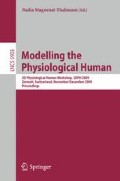Abstract
This paper presents a method and a set of detailed musculoskeletal models for estimation of individual muscle forces for a given movement based on inverse dynamics. The basic methodology and the construction of the human body model library are presented and examples of prediction and validation of muscle forces in the mandible and the neck are given. Furthermore it is demonstrated how musculoskeletal models give insight into the motor control from a functional point of view. The paper concludes that motor control changes and biomechanics are dependent on each other and musculoskeletal models can help us to understand changes in muscle coordination and muscle force for different kinds of situations.
Access this chapter
Tax calculation will be finalised at checkout
Purchases are for personal use only
Preview
Unable to display preview. Download preview PDF.
References
An, K.N., Kwak, B.M., Chao, E.Y., Morrey, B.F.: Determination of muscle and joint forces: a new technique to solve the indeterminate problem. Journal of Biomechanical Engineering 106, 364–367 (1984)
Buckle, P.W., Devereux, J.J.: The nature of work-related neck and upper limb musculoskeletal disorders. Applied Ergonomics 33, 207–217 (2002)
Cattaneo, P.M., Kofod, T., Dalstra, M., Melsen, B.: Using the finite element method to model the biomechanics of the asymmetric mandible before, during and after skeletal correction by distraction osteogenesis. Computer Methods in Biomechanics and Biomedical Engineering 8, 157–165 (2005)
Damsgaard, M., Rasmussen, J., Christensen, S.T., Surma, E., de Zee, M.: Analysis of musculoskeletal systems in the AnyBody Modeling System. Simulation Modelling Practice and Theory 14, 1059–1070 (2006)
de Zee, M., Dalstra, M., Cattaneo, P.M., Rasmussen, J., Svensson, P., Melsen, B.: Validation of a musculo-skeletal model of the mandible and its application to mandibular distraction osteogenesis. Journal of Biomechanics 40, 1192–1201 (2007a)
de Zee, M., Hansen, L., Wong, C., Rasmussen, J., Simonsen, E.B.: A generic detailed rigid-body lumbar spine model. Journal of Biomechanics 40, 1219–1227 (2007b)
de Zee, M., Falla, D., Farina, D., Rasmussen, J.: A detailed rigid-body cervical spine model based on inverse dynamics. Journal of Biomechanics 40, S284 (2007c)
Falla, D.L., Jull, G.A., Hodges, P.W.: Patients with neck pain demonstrate reduced electromyographic activity of the deep cervical flexor muscles during performance of the craniocervical flexion test. Spine 29, 2108–2114 (2004)
Klein Horsman, M.D., Koopman, H.F., van der Helm, F.C., Prose, L.P., Veeger, H.E.: Morphological muscle and joint parameters for musculoskeletal modelling of the lower extremity. Clinical Biomechanics 22, 239–247 (2007)
Rasmussen, J., Damsgaard, M., Voigt, M.: Muscle recruitment by the min/max criterion – a comparative numerical study. Journal of Biomechanics 34, 409–415 (2001)
Swennen, G., Schliephake, H., Dempf, R., Schierle, H., Malevez, C.: Craniofacial distraction osteogenesis: a review of the literature: Part 1: clinical studies. International Journal of Oral and Maxillofacial Surgery 30, 89–103 (2001)
van Bolhuis, B.M., Gielen, C.C.: A comparison of models explaining muscle activation patterns for isometric contractions. Biological Cybernetics 81, 249–261 (1999)
van der Helm, F.C.: A finite element musculoskeletal model of the shoulder mechanism. Journal of Biomechanics 27, 551–569 (1994)
van der Horst, M.J.: Human head neck response in frontal, lateral and rear end impact loading - modelling and validation. Technische Universtiteit Eindhoven, Eindhoven, The Netherlands (2002)
Wilke, H., Neef, P., Hinz, B., Seidel, H., Claes, L.: Intradiscal pressure together with anthropometric data–a data set for the validation of models. Clinical Biomechanics 16, S111–S126 (2001)
Author information
Authors and Affiliations
Editor information
Editors and Affiliations
Rights and permissions
Copyright information
© 2009 Springer-Verlag Berlin Heidelberg
About this paper
Cite this paper
de Zee, M., Rasmussen, J. (2009). Using Musculoskeletal Modeling for Estimating the Most Important Muscular Output – Force. In: Magnenat-Thalmann, N. (eds) Modelling the Physiological Human. 3DPH 2009. Lecture Notes in Computer Science, vol 5903. Springer, Berlin, Heidelberg. https://doi.org/10.1007/978-3-642-10470-1_6
Download citation
DOI: https://doi.org/10.1007/978-3-642-10470-1_6
Publisher Name: Springer, Berlin, Heidelberg
Print ISBN: 978-3-642-10468-8
Online ISBN: 978-3-642-10470-1
eBook Packages: Computer ScienceComputer Science (R0)

